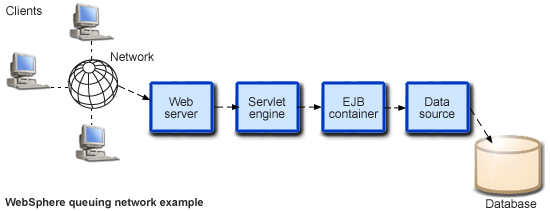Queuing network
WebSphere Application Server contains interrelated components that must be tuned to support the custom needs of your e-business application. These adjustments help the system achieve maximum throughput while maintaining the overall stability of the system. This group of interconnected components is known as a queuing network. These queues or components include the network, Web server, Web container, EJB container, data source, and possibly a connection manager to a custom back-end system. Each of these resources represents a queue of requests waiting to use that resource. Various queue settings include:
- IBM HTTP Server: ThreadsPerChild
- Web container: Thread pool maximum size, HTTP transports MaxKeepAliveConnections, and MaxKeepAliveRequests
- Object Request Broker: Thread pool maximum size
- Data source: Connection pooling and Statement cache size
- Java Messaging Service: Listener service thread pool maximum size, Listener port maximum sessions, Listener port maximum messages, and Connection pooling

Most of the queues that make up the queuing network are closed queues. A closed queue places a limit on the maximum number of requests present in the queue, while an open queue has no limit. A closed queue supports strict management of system resources. For example, the Web container thread pool setting controls the size of the Web container queue. If the average servlet running in a Web container creates 10MB of objects during each request, a value of 100 for thread pools limits the memory consumed by the Web container to 1GB.
In a closed queue, requests can be active or waiting. An active request is doing work or waiting for a response from a downstream queue. For example, an active request in the Web server is doing work, such as retrieving static HTML, or waiting for a request to be processed in the Web container. A waiting request is waiting to become active. The request remains in the waiting state until one of the active requests leaves the queue.
All Web servers supported by WebSphere Application Server are closed queues, as are WebSphere Application Server data sources. You can configure Web containers as open or closed queues. In general, it is recommended that you use closed queues. EJB containers are open queues. If there are no threads available in the pool, a new thread is created for the duration of the request.
If enterprise beans are called by servlets, the Web container limits the number of total concurrent requests into an EJB container, because the Web container also has a limit. The Web container limits the number of total concurrent requests only if enterprise beans are called from the servlet thread of execution. Nothing prevents a servlet from creating threads and overloading the EJB container with requests. Therefore, servlets should not create their own work threads.
Queue configuration tips
This topic provides tips to help you tune the queuing network configuration.Enterprise bean method invocation queuing
This topic provides information about invocation queuing for remote method invocations.